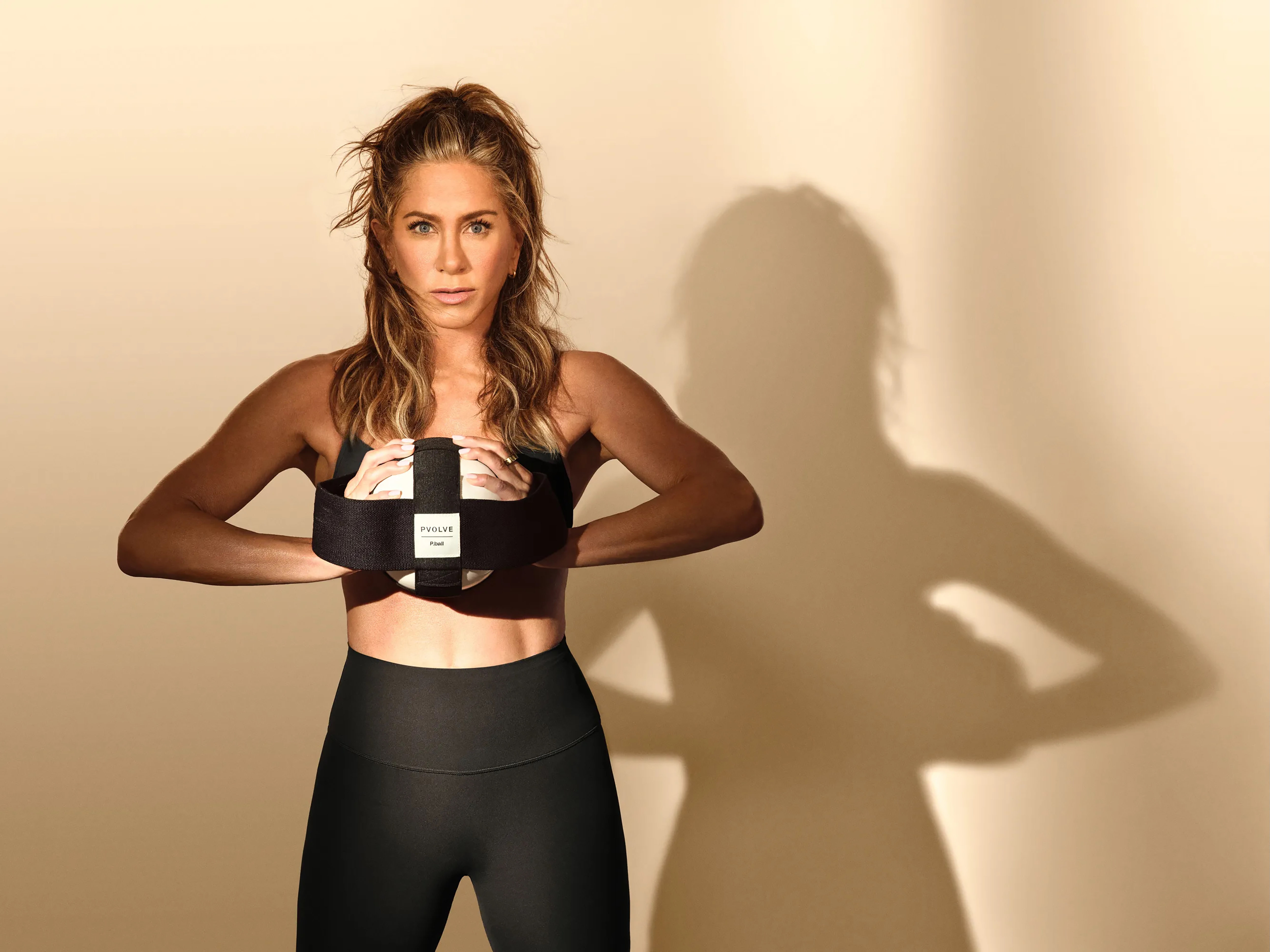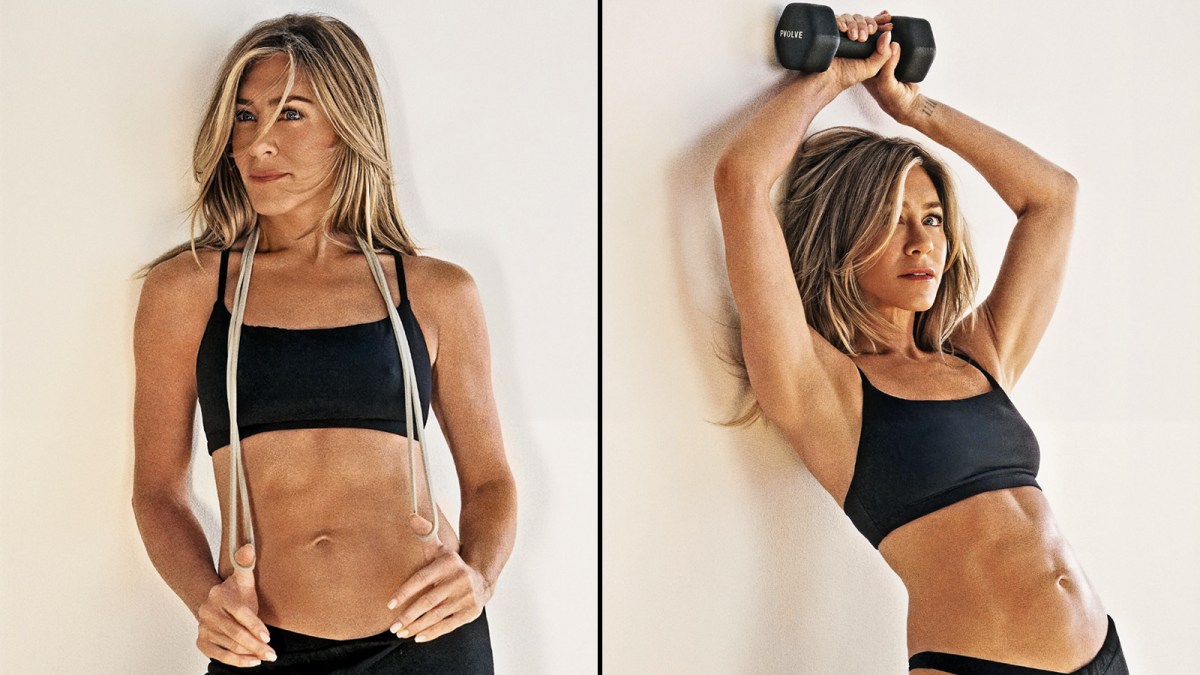Jennifer Aniston’s toned abs and youthful-looking physique are perhaps not as surprising as the manner in which she achieved them. Aniston, 56, is the face — and body — of Pvolve, a resistance workout method that involves small, precise exercises to target even hard-to-isolate muscles. It involves no high-impact movement and uses really light weights. In fact the heaviest weight you will use in a Pvolve session is 3lb, a load that might be lifted with the little finger by many of the gym-strength brigade. Can micro-lifting in this way really get you strong?
Conventional wisdom is that the bigger the weight you can lift, the better the results in terms of muscle growth and definition. Women are often told they need to lift, and lift heavy, to offset a decline in muscle mass and bone density that occurs during and after the menopause. It has led to a trend for serious strength training in gyms using kettlebells, dumbbells and barbells with a progressively heftier resistance — which can usually only be lifted three to five times.
Surprisingly, however, trainers and exercise physiologists insist there is no clear evidence that a few hardcore heavy weights sessions outperform more frequent lighter lifting in terms of results. “There’s so much research to show that lifting light and lifting heavy will both elicit significant gains in lean muscle mass,” says Dalton Wong, a performance coach. “The narrative that heavy is best is flawed.”
• Everything you know about abs is wrong
For more than a decade Stuart Phillips, a professor in the department of kinesiology at McMaster University in Canada, and his colleagues have railed against the popular idea that heavy weights are the only way to get stronger and more toned, with studies suggesting that lifting lighter weights for 20 to 30 repetitions, sometimes more, towards the point of exhaustion can also bring significant gains.
The most recent of these was a 2023 review of 192 published trials involving more than 5,000 women and men in the British Journal of Sports Medicine, making it the largest study of its kind. Results showed that every form of training, including bodyweight exercises such as planks, lunges and push-ups, resulted in strength and muscle mass gains.
When it came to weights there were subtle differences in outcome. Phillips and his team showed that heavy weights had the biggest effect on maximising muscle strength, while for boosting muscle size the weight lifted was less important and repeated exercises with lighter weights were more beneficial.
Wong says a lot comes down to personal preference. The key with both approaches is to reach what personal trainers call the point of failure, when your muscles start quivering and you can’t keep going any longer. With lighter weights that could mean 30 repetitions and ultimately spending more time at the gym but with generally less soreness to deal with when you finish. “Working to failure with very heavy weights is likely to cause a higher level of muscle damage and fatigue,” Wong says. “So while the session is over quickly, the recovery time is often longer.”
• How I got into the best shape of my life at 45
Weight training little and often can be more manageable — and just as effective — as doing one or two heavy lifting sessions. George Morris, a lecturer in sport and exercise science at St Mary’s University, Twickenham, says anyone starting out should be cautious. “If you can’t do a bodyweight squat with good technique then by adding even light weights you will sacrifice technique,” he says. “If ultimately you want to lift heavy weights you need to start with bodyweight exercises then add light weights to build up skill and proficiency before experimenting with progression.”
Wong says heavy weights won’t suit everyone and you should factor in injury risk. “If you are in your twenties or thirties then the risk of lifting heavy is relatively low,” Wong says. “But from your fifties and sixties you should think about going lighter or progressing slowly with heavy weights, as straining a muscle through overexertion could put you out for weeks.”

Aniston, 56
PVOLVE/ZOEY GROSSMAN
Don’t think you are short-changing yourself. Even Aniston’s 3lb weights can bring visible A-list worthy results, according to a study published this year in which researchers from the University of Exeter looked specifically at the benefits of the Pvolve approach. Results, published in the journal Medicine & Science In Sports & Exercise, found that it increased hip strength, dynamic balance, flexibility and lean body mass in women aged between 40 and 60 who did 30 to 35-minute classes for 12 weeks.
“We’ve shown it’s effective at improving strength and balance in women during and postmenopause,” said Professor Francis Stephens, who led the study. Strength training is essential for health but how regularly you do it is more important than how much weight you lift. “The most important factor is that you do some strength work — light, heavy or a combination of both — with consistency for the best results,” he says.
• How to start weight training in midlife
Lift light or heavy?Start without weights
Whether you lift heavy or light, the outcome will be determined by your technique. “Even elite athletes will perform no-weight repetitions using just their body weight to ensure form is correct,” Morris says. “I always recommend that even experienced weightlifters who lift heavy weights do non-weight exercises as part of the preparation for a session.”
If you want to lift heavy, start light
If you’ve never used weights and like the idea of building up to heavy weights, you will need to start light. Aim for a weight you can comfortably lift 10-12 times, with the last two reps posing more of challenge. For complete beginners this might be 2kg (or 4lb) to 3kg for dumbbells — or less. “Everyone will have a different comfort level but diving in with 10kg to 12kg dumbbells is inadvisable,” Wong says. “Ideally invest in a set of 2kg, 4kg, 6kg, 8kg and 10kg dumbbells that allows for progression when you are ready.”
Should you lift weights fast or slow?
This depends on how heavy the weights are. If you are lifting light weights then faster repetitions — or pulses — can help to achieve results. With heavy weights there are benefits to lifting and lowering in a slow and controlled way. “The lowering or eccentric phase of a weights movement should be slow to help with strength gains,” Wong says. “Ultimately a combination of lighter, faster weights and slower, heavier sessions on different days is the best approach.”
• Read more expert advice on healthy living, fitness and wellbeing
Don’t neglect the gym weights machines
At home the option is usually dumbbells and kettlebells. “If you are a gym member do ask for an induction on how to use the weights machines,” Wong says. “They give you the option of lifting incrementally heavier weights within a more tightly controlled environment, which is great when starting out.”
Aim to lift three to four times a week
Weight training needs to be regular for the greatest rewards. Three or four times a week is a good starting point, Wong says. “Don’t ditch other activities for weight training alone,” he says. “The biggest gains come when weight training and aerobic exercise go hand in hand.”
Add an element of progression
Your muscles need a progressively greater stimulus. This doesn’t necessarily mean adding a lot more weight; it can be increasing the repetitions or sets you do with lighter weights. “Don’t rush things as it’s a fast route to injuries,” Wong says. “Progress in increments once you find you can easily accomplish several sets of an exercise.” A rule of thumb is to increase either the weight or the number of reps you perform by no more than 10 per cent every two to three weeks when you are starting out.

